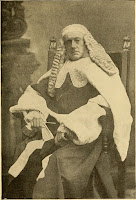In my most recent novel, Dead Set Delphinia, my heroine in the fall of 1881 finds herself
involved with the furniture store owner in the relatively new mining town of Jubilee
Springs. Since he has the skills to nail together a pine box, he has also
become the coffin-maker and, by default, the town mortician. This was not all
that unusual. While researching Lundy, California for the Eastern Sierra Brides 1884 series I wrote, I
found in real life the furniture store owner, Andrew Barnes, was also the
coffin-builder and mortician for that community.
 |
| 1870-1880's |
As part of the plot, in Dead Set Delphinia,
when Bennett Nighy asks for Delphinia’s help to act as a hostess
at the viewing of one of the town’s beloved deceased citizens, she decides it
is time to visit the seamstress in order to see if the woman can help her put
together an appropriate gown in black bombazine.
I sew, and I have been known to frequent fabric stores.
However, my first recollection of being exposed to the fabric bombazine came
about as I read The
Widow of the South by
Robert Hicks. This novel, based on a true story, tells about Carnton
Plantation, the scene of a horrific Civil War battle in 1864, how the land became
a cemetery for the multitude of Confederate dead. It continued to be watched
over by the widow of the plantation owner who, until her death, wore nothing but
black bombazine mourning dresses.
The word “bombazine” struck me as unusual. The way my crazy
mind works, it put me in mind of cabaret music – you know: bomba-bomba-bomba.
Exactly what is bombazine?
bom·ba·zine
[ˈbämbəzēn]
NOUN:
a twilled dress fabric of worsted and
silk or cotton.
Bombazine, or bombasine,
is a fabric originally made of silk or silk and wool, and now also made of cotton
and wool or of wool alone. Quality bombazine is made with a silk warp and a worsted
weft. It is twilled or corded and used for dress-material. Black bombazine was
once used largely for mourning wear, but the material had gone out of fashion
by the beginning of the 20th century. In the nineteenth century, the fabric was
mostly made in Norwich, England.
Bombazine was also used to make the black robes worn by judges.
Here
are some interesting facts about bombazine:
•
Bombazine used to be exclusively made from silk. However, the subsequent need
to make it affordable to the masses necessitated the shift from silk to cotton
and wool. In many societies in olden times, the price of silk was too
exorbitant to merit buying bombazine. However, because bombazine cannot compete
with velvet as a luxury material, it was forced to find another niche in a more
affordable price range.
•
Twilling or cording are the only known methods known for making bombazine.
Twilling is process of weaving where cloth strands are pushed through other
cloth strands positioned lengthwise on a weaving machine. The resulting cloth
has a characteristic diagonal pattern that is highly resistant to ordinary wear
and tear. More modern incarnations of twilled fabric include denim which is
used for making jeans.
•
The use of bombazine as a mourner’s cloth was precipitated by the observation
that the fabric has just enough sheen and sparkle for a mourning widow. Too
much sparkle would have been construed as a blatant display of disrespect to
the dead while cloth with less shine would have been a symbol of low status in
society which was not ideal in an era where Victorian affluence was the
prevailing theme.
 |
| Mary Wylie King, widow 1920 |
•
While bombazine can be made in a variety of colors, it is predominantly
manufactured and sold in black. This is consistent with its status as the cloth
of choice for mourner’s dresses.
• Today, bombazine no longer has the same status as it once had in Victorian
times. Bombazine is still sold in many shops but in substantially lower
volumes. The values of the modern times has pushed the material to relative
obscurity so much so that not many people are familiar with this type of
fabric.
•
Modern applications of bombazine include lining material in caskets and jewelry
boxes. The next time you see a casket, check out the inner lining so you’ll
know firsthand what bombazine looks like.
Sources:
Wikipedia
http://www.typesofclothingfabrics.com/bombazine.shtml
avictorian.com
Dead Set Delphinia is a full novel and the fourth of Zina Abbott's books in the Sweethearts of Jubilee Springs series. You may read more about it by CLICKING HERE.
Her fifth book, Evasive Eddie Joe, is scheduled for publication October 31st.
Zina Abbott has available three other novellas in the Sweethearts of Jubilee Springs series.
Book 3: Aaron’sAnnulment Bride
Book 6: Cat's Meow
Book 7: Bargain Bessie
~o0o~








3 comments:
This is so fascinating. I have read the word bombazine in so many historical novels and never really knew what it was!
Cultures are funny. For me, in Portugal, Europe, bombazine is one of the most common words and fabrics. Since a kid, I had skirts, pants, hats, gloves, coats, bed and cushion covers made of it. Bombazine clothes are mostly for cold autumn and winter, though.
Early in Gone with the Wind, Scarlett O’Hara considers wearing a black bombazine dress with “princess lace collar” to the barbecue at Twelve Oaks. She fears it will make her look too sedate, though, so switches to a flowered muslin dress instead.
Post a Comment